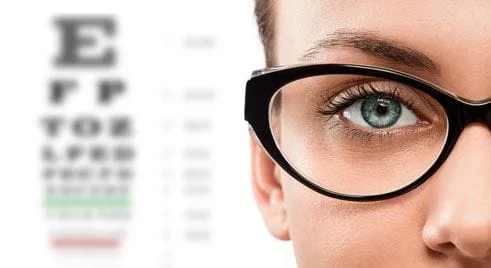Comprehensive Eyeglass Exams
Even if you don't notice a difference in your vision, you should visit your optometrist regularly for a vision examination. This can help detect eye health problems. For those who have a vision deficit, your optometrist can prescribe glasses. Part of your eye exam will also consist of getting fitted for eyeglasses and choosing your frames with Dr. Nathan Anderson, but not until after a thorough evaluation with your optometrist.
Visual Acuity Test
Once you come in for your appointment, the first portion of your exam consists of a visual acuity test. This assessment determines the severity of your vision deficit and helps our optometrist figure out the correct strength of vision correction necessary. During this part of your appointment, your optometrist has you look into a machine with different lines magnified at different powers. You inform your eye doctor about which one you can read clearly.
To test you for astigmatism, you'll need to look at two different images and identify which one appears clearer. You'll go through a series of these comparisons. Based on your results, your optometrist can determine if you have astigmatism and to what degree.
Eye Health Exam
The next part of your comprehensive eyeglass exam is an eye health screening. The tests your optometrist conduct depends upon your specific medical history, age, and current eye health problems. Your optometrist will look into your eyes using a special magnifying device. It allows our eye doctor to see the inside of your eye to look for issues, such as diabetic retinopathy and macular degeneration.
Your eye doctor may perform an eye pressure testing using a machine that blows air into your eyes. It measures your eye's pressure, and high eye pressure can signify an issue like glaucoma. Other testing is possible as well.
Eyeglass Fitting
After checking your eye health and visual acuity, our optician, Dr. Nathan Anderson, can measure you for glasses. This process is relatively quick and consists of gathering information to fit you with the correct size.
The following are areas that must fit properly for your glasses to be comfortable:
- Frame width - This is the horizontal portion on the front of your glasses. It's a measurement from the outer side of one corner of your frame to the other.
- Bridge - The bridge is the small area in between each frame. It's the part of your glasses that rests on the bridge of your nose.
- Lens height - The height of your lens is a measurement of how large your lens is vertically.
- Temple arm - The temple arm is the part of your glasses that extends from your lenses to behind your ear.
The eyeglass fitting also consists of you choosing the desired frames and style of arms you want for your glasses. If you need help to decide, Dr. Anderson understands which frames fit what shaped-face and can assist with you with deciding. We have a wide variety to choose from, so you can find an option that you feel confident in.
Once you have your new glasses, you try them on in our office. If they need any adjustments, we can perform them on the spot.
Comprehensive eyeglass exams allow you to find the glasses that you love in a prescription that optimizes your vision. The process seems extensive, but it's all necessary to make sure your eyes are healthy and you're seeing clearly.

